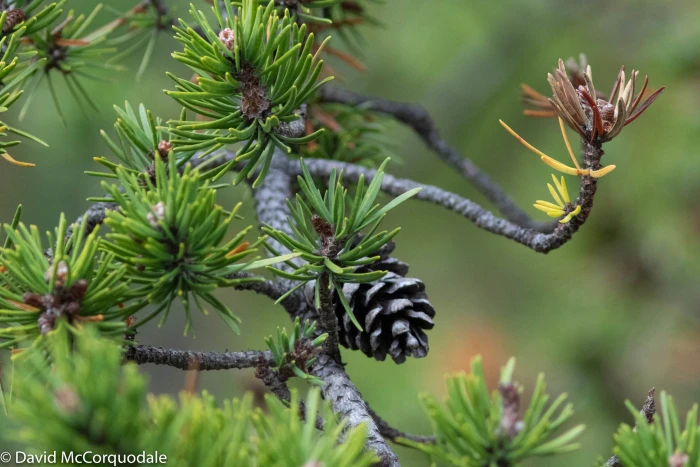Jack Pine
(Pinus banksiana)
Jack Pine (Pinus banksiana)
/
/

David McCorquodale
CC BY 4.0
Image By:
David McCorquodale
Recorded By:
Copyright:
CC BY 4.0
Copyright Notice:
Photo by: David McCorquodale | License Type: CC BY 4.0 | License URL: http://creativecommons.org/licenses/by/4.0/ | Rights Holder: David McCorquodale | Publisher: iNaturalist | Date Created: 2020-10-24T10:36:36-07:00 |












































Estimated Native Range
Climate Requirements for Himeji, Japan
| This Plant | Your Site | Plant Suitability for Your Location | ||
|---|---|---|---|---|
| • Precipitation | 10" - 121" | 54" | Aquatic | Aquatic |
| • High Temp. | 33°F - 99°F | 90°F | Your summer temperatures are normal for this plant. | Excellent |
| • Low Temp. | -30°F - 38°F | 32°F | Your winter temperatures are normal for this plant | Excellent |
This plant may not grow well at your location - your precipitation is too high.
Summary
Pinus banksiana, commonly known as Jack Pine, is an evergreen tree native to open woodlands and areas with poor soil conditions across much of Canada and the northeastern United States. It typically ranges from 9–22 m (30–72 ft) in height, with some individuals remaining shrub-sized due to challenging growing environments. Jack Pine often grows with an irregular form, similar to Pitch Pine (Pinus rigida), and is well-adapted to sandy or rocky soils. It plays a crucial role in its ecosystem, particularly in fire-adapted landscapes where its serotinous cones open following forest fires, allowing for regeneration.
Jack Pine is valued for its resilience and ability to thrive in poor soil conditions, making it suitable for reforestation projects and naturalistic plantings. Its irregular shape and forward-pointing cones add visual interest to landscapes. In cultivation, it requires full sun and can tolerate a range of water conditions, from low to moderate, and is adaptable to various soil drainage types. While not commonly used for ornamental purposes, it is an important species for wildlife habitat and erosion control. The wood of Jack Pine is moderately hard and light brown, but it is considered weak and is primarily used for pulpwood and lumber for construction. Gardeners should be aware that Jack Pine can be susceptible to various pests and diseases, including pine beetle infestations and rust diseases. It is also important to note that due to its fire-adaptive nature, it should not be planted in regions prone to wildfires where it could contribute to fire spread.CC BY-SA 4.0
Jack Pine is valued for its resilience and ability to thrive in poor soil conditions, making it suitable for reforestation projects and naturalistic plantings. Its irregular shape and forward-pointing cones add visual interest to landscapes. In cultivation, it requires full sun and can tolerate a range of water conditions, from low to moderate, and is adaptable to various soil drainage types. While not commonly used for ornamental purposes, it is an important species for wildlife habitat and erosion control. The wood of Jack Pine is moderately hard and light brown, but it is considered weak and is primarily used for pulpwood and lumber for construction. Gardeners should be aware that Jack Pine can be susceptible to various pests and diseases, including pine beetle infestations and rust diseases. It is also important to note that due to its fire-adaptive nature, it should not be planted in regions prone to wildfires where it could contribute to fire spread.CC BY-SA 4.0
Plant Description
- Plant Type: Tree
- Height: 30-70 feet
- Width: 20-30 feet
- Growth Rate: Rapid
- Flower Color: N/A
- Flowering Season: Non-Flowering
- Leaf Retention: Evergreen
Growth Requirements
- Sun: Full Sun
- Water: Low
- Drainage: Fast, Medium
Common Uses
Bird Garden, Border Plant, Deer Resistant, Drought Tolerant, Fragrant, Low Maintenance, Rabbit Resistant, Rock Garden, Salt Tolerant, Street Planting
Natural Habitat
Open woodlands and areas with poor soil conditions
Other Names
Common Names: Banksian Pine , Hudson Bay Pine , Labrador Pine , Gray Pine , Scrub Pine , Black Pine , Banks-Kiefer , Banks Kiefer , Cyprès , Pin Chétif
Scientific Names: Pinus banksiana , Pinus divaricata , Pinus banksiana f. procumbens , Pinus hudsonica , Pinus divaricata f. procumbens , Pinus hudsonia , Pinus rupestris , Pinus sylvestris subsp. divaricata , Pinus sylvestris var. divaricata
GBIF Accepted Name: Pinus banksiana Lamb.